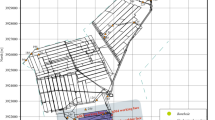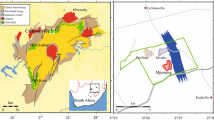Abstract
Tectonic stress is an important parameter for understanding the dynamics of underground engineering and for the exploitation of coalbed methane. Multiple-period structural features usually have complex spatial relationships in tectonic superposition areas, which provides evidence for identification of the sequence of the tectonic stress period. Conjugated joints and slickensides are used to reconstruct the tectonic stress of the No. 8 Mine in Pingdingshan. Based on the geological unit division and field measurements, data on hundreds of joints and slickensides are collected from 33 stations. The tectonic stress results indicated by the conjugated joints show that there are mainly four directions of tectonic stress: NEE-SWW, NW-SE, NE-SW, and NNE-SSW. The tectonic stress results of the slickensides indicate that there are mainly four directions of tectonic stress: NNE-SSW, NNW-SSE, NEE-SWW, and NW-SE. According to the systematic analysis of the joints and slickensides, this paper separates the superposed joint and slickenside sets and identifies the tectonic stress periods with their abutting relationships. Three tectonic stress periods are determined and the sequence of the tectonic stress periods is NE-SW, NW-SE, and NEE-SWW. The results are consistent with other tectonic stress measurements for both the region and the locality.










Similar content being viewed by others
References
Jiang B, Qu ZH, Wang GG, Li M (2010) Effects of structural deformation on formation of coalbed methane reservoirs in Huaibei coalfield, China. Int J Coal Geol 82(3–4):175–183
Ju W, Shen J, Qin Y (2018) In-situ stress distribution and coalbed methane reservoir permeability in the Linxing area, eastern Ordos Basin, China. Front Earth Sci 12(3):545–554
Cabaniss HE, Gregg PM, Grosfils EB (2018) The role of tectonic stress in triggering large silicic caldera eruptions. Geophys Res Lett 45(9):3889–3895
Groshong RH, Pashin JC, Mclntyer MR (2008) Structural controls on fractured coal reservoirs in the southern Appalachian Black Warrior foreland basin. J Struct Geol 31(9):874–886
Chen SD, Tang DZ, Tao S (2017) In-situ stress measurements and stress distribution characteristics of coal reservoirs in major coalfields in China: implication for coalbed methane (CBM) development. Int J Coal Geol 182:66–84
Eyal Y, Gross MR, Engelder T, Becker A (2001) Joint development during fluctuation of the regional stress field in southern Israel. J Struct Geol 23(2–3):279–296
Huang SQ, Dong SW, Zhang YQ (2015) The deformation and tectonic evolution of the Huahui Basin, Northeast China, during the Cretaceous-Early Cenozoic. J Asian Earth Sci 114:717–731
Tang Y, Yang F, Qi QL (2018) Analysis of the tectonic stress field of SE Sichuan and its impact on the preservation of shale gas in lower Silurian Longmaxi formation of the Dingshan region, China. J Geol Soc India 92(1):92–100
Diabat AA (2013) Fracture systems of granites and Quaternary deposits of the area east of Aqaba: indicators of reactivation and neotectonic activity. Arab J Geosci 6(3):679–695
Blenkinsop TG (2008) Relationships between faults, extension fractures and veins, and stress. J Struct Geol 30(5):622–632
Wilson JE, Chester JS, Chester FM (2003) Microfracture analysis of fault growth and wear processes, Punchbowl Fault, San Andreas system, California. J Struct Geol 25(11):1855–1873
Chuang X, Hai HW, Zhi CL (2015) Multilayer stress from gravity and its tectonic implications in urban active fault zone: a case study in Shenzhen, South China. J Appl Geophys 114:174–182
Eyal Y, Osadetz KG, Feinstein S (2004) Evidence for reactivation of Eocene joints and pre-Eocene foliation planes in the Okanagan core-complex, British Columbia, Canada. J Struct Geol 28(11):2109–2120
Brandes SC, Tanner DC (2013) Paleostress pattern and salt tectonics within a developing foreland basin (north-western Subhercynian Basin, northern Germany). Int J Earth Sci 102(8):2239–2254
King RC, Hillis RR, Tingay MR (2010) Present-day stresses in Brunei, NW Borneo: superposition of deltaic and active margin tectonics. Basin Res 22(2):236–247
Saintot A, Angelier J (2002) Tectonic paleostress fields and structural evolution of the NW-Caucasus fold-and-thrust belt from Late Cretaceous to Quaternary. Tectonophysics 357(1–4):1–31
Lisle RJ, Orife TO, Arlegui L, Liesa C, Srivastava DC (2006) Favoured states of palaeostress in the Earth’s crust: evidence from fault-slip data. J Struct Geol 28(6):1051–1066
Zoback MD, Barton CA, Brudy M (2003) Determination of stress orientation and magnitude in deep wells. Int J Rock Mech Min Sci 40(7–8):1049–1076
Chester FM, Chester JS (2000) Stress and deformation along wavy frictional faults. J Geophys Res 105(B10):23421–23430
Naimi GN, Khatib MM, Nazari H (2015) Present-day tectonic regime and stress patterns from the formal inversion of focal mechanism data, in the North of Central-East Iran Blocks. J Afr Earth Sci 111:113–126
Lucia F, Vaclav V (2018) Tectonic stress regime in the 2003–2004 and 2012–2015 earthquake swarms in the Ubaye Valley, French Alps. Pure Appl Geophys 175(6):1997–2008
Kaymakci N, White SH, Vandijk PM (2003) Kinematic and structural development of the Qankiri Basin (Central Anatolia, Turkey): a paleostress inversion study. Tectonophysics 364(1–2):85–113
Yadav R, Tiwari VM (2018) Numerical simulation of present day tectonic stress across the Indian subcontinent. Int J Earth Sci 107(7):2449–2462
Ghosh A, Holt WE, Wen LM (2013) Predicting the lithospheric stress field and plate motions by joint modeling of lithosphere and mantle dynamics. J Geophys Res 118(1):346–368
Wan TF (1988) Palo-tectonic stress fields. Geological Publishing House, Beijing
Jiang L, Qiu Z, Wang QC (2016) Joint development and tectonic stress field evolution in the southeastern Mesozoic Ordos Basin, west part of North China. J Asian Earth Sci 127:47–62
Simonova V, Plasienka D (2017) Stepwise clockwise rotation of the Cenozoic stress field in the Western Carpathians as revealed by kinematic analysis of minor faults in the Manin Unit (western Slovakia). Geol Quart 61(1):251–264
Otsubo M, Shigematsu N, Imanishi K (2013) Temporal slip change based on curved slickenlines on fault scarps along Itozawa fault caused by 2011 Iwaki earthquake, northeast Japan. Tectonophysics 608:970–979
Diabat AA (2009) Structural and stress analysis in Amman area, based on fault slip data. J Afr Earth Sci 54(5):155–162
Phillipson SE (2005) Laramide orogeny-related controls on coal mine ground instability in Cretaceous coal seams, southern Rocky Mountain foreland. Int J Coal Geol 64(1–2):20–43
Peacock D, Sanderson DJ, Rotevatn A (2018) Relationships between fractures. J Struct Geol 106:41–53
Acknowledgements
The authors wish to thank anonymous reviewers whose comments and suggestions improved the exposition of the paper. The work also benefited from discussions with the partners of Henan Polytechnic University.
Author information
Authors and Affiliations
Corresponding author
Ethics declarations
Conflict of Interest
The author declares that there is no conflict of interest.
Additional information
Publisher’s Note
Springer Nature remains neutral with regard to jurisdictional claims in published maps and institutional affiliations.
Rights and permissions
About this article
Cite this article
Lin, C. Tectonic Stress Reconstruction Based on Structural Features in Tectonic Superposition Areas. Mining, Metallurgy & Exploration 37, 387–397 (2020). https://doi.org/10.1007/s42461-019-00174-9
Received:
Accepted:
Published:
Issue Date:
DOI: https://doi.org/10.1007/s42461-019-00174-9




